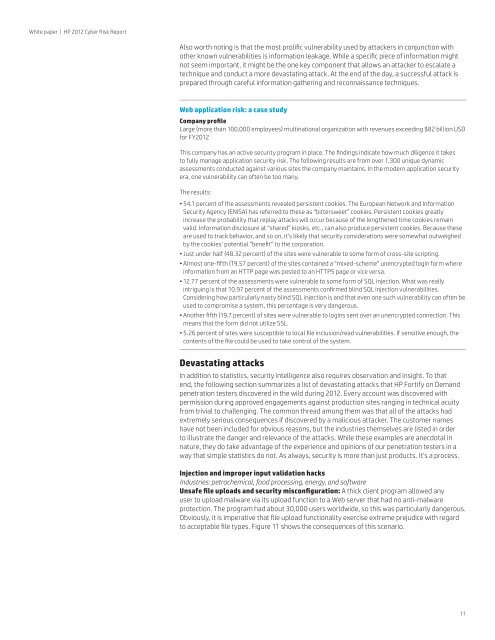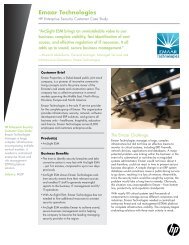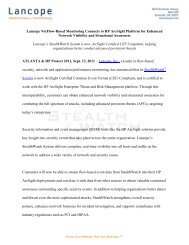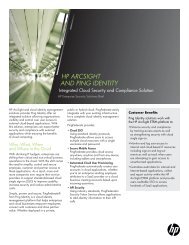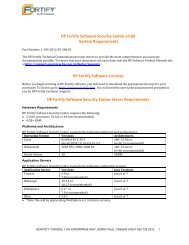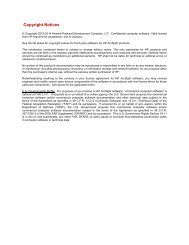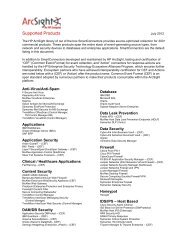HP 2012 Cyber Risk Report
HP 2012 Cyber Risk Report
HP 2012 Cyber Risk Report
- No tags were found...
Create successful ePaper yourself
Turn your PDF publications into a flip-book with our unique Google optimized e-Paper software.
White paper | <strong>HP</strong> <strong>2012</strong> <strong>Cyber</strong> <strong>Risk</strong> <strong>Report</strong>Also worth noting is that the most prolific vulnerability used by attackers in conjunction withother known vulnerabilities is information leakage. While a specific piece of information mightnot seem important, it might be the one key component that allows an attacker to escalate atechnique and conduct a more devastating attack. At the end of the day, a successful attack isprepared through careful information gathering and reconnaissance techniques.Web application risk: a case studyCompany profileLarge (more than 100,000 employees) multinational organization with revenues exceeding $82 billion USDfor FY<strong>2012</strong>This company has an active security program in place. The findings indicate how much diligence it takesto fully manage application security risk. The following results are from over 1,300 unique dynamicassessments conducted against various sites the company maintains. In the modern application securityera, one vulnerability can often be too many.The results:• 54.1 percent of the assessments revealed persistent cookies. The European Network and InformationSecurity Agency (ENISA) has referred to these as “bittersweet” cookies. Persistent cookies greatlyincrease the probability that replay attacks will occur because of the lengthened time cookies remainvalid. Information disclosure at “shared” kiosks, etc., can also produce persistent cookies. Because theseare used to track behavior, and so on, it’s likely that security considerations were somewhat outweighedby the cookies’ potential “benefit” to the corporation.• Just under half (48.32 percent) of the sites were vulnerable to some form of cross-site scripting.• Almost one-fifth (19.57 percent) of the sites contained a “mixed-scheme” unencrypted login form whereinformation from an HTTP page was posted to an HTTPS page or vice versa.• 12.77 percent of the assessments were vulnerable to some form of SQL injection. What was reallyintriguing is that 10.97 percent of the assessments confirmed blind SQL injection vulnerabilities.Considering how particularly nasty blind SQL injection is and that even one such vulnerability can often beused to compromise a system, this percentage is very dangerous.• Another fifth (19.7 percent) of sites were vulnerable to logins sent over an unencrypted connection. Thismeans that the form did not utilize SSL.• 5.26 percent of sites were susceptible to local file inclusion/read vulnerabilities. If sensitive enough, thecontents of the file could be used to take control of the system.Devastating attacksIn addition to statistics, security intelligence also requires observation and insight. To thatend, the following section summarizes a list of devastating attacks that <strong>HP</strong> Fortify on Demandpenetration testers discovered in the wild during <strong>2012</strong>. Every account was discovered withpermission during approved engagements against production sites ranging in technical acuityfrom trivial to challenging. The common thread among them was that all of the attacks hadextremely serious consequences if discovered by a malicious attacker. The customer nameshave not been included for obvious reasons, but the industries themselves are listed in orderto illustrate the danger and relevance of the attacks. While these examples are anecdotal innature, they do take advantage of the experience and opinions of our penetration testers in away that simple statistics do not. As always, security is more than just products. It’s a process.Injection and improper input validation hacksIndustries: petrochemical, food processing, energy, and softwareUnsafe file uploads and security misconfiguration: A thick client program allowed anyuser to upload malware via its upload function to a Web server that had no anti-malwareprotection. The program had about 30,000 users worldwide, so this was particularly dangerous.Obviously, it is imperative that file upload functionality exercise extreme prejudice with regardto acceptable file types. Figure 11 shows the consequences of this scenario.11


